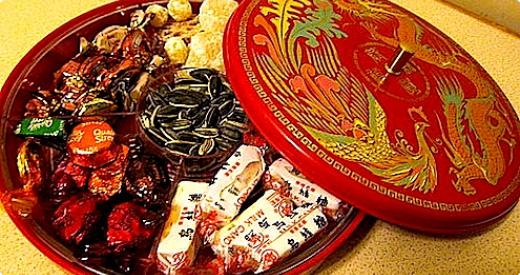Describing Wines with Chinese New Year Ingredients

Chinese New Year boxes, or the tray of luck, is a traditional feature in Chinese homes around this time to welcome guests and relatives in their homes. They come in octagonal shaped boxes, with eight compartments for seeds and sweetmeats. The eight sides of the tray symbolises the positive connotation of the number eight: paat in Cantonese or ba in Putonghua has the same sound as “prosperity” or “good fortune”.
Chinese food chosen during this celebratory season are filled with auspicious meanings. Asian Palate takes a look at five very popular Chinese New Year delicacies and share their meanings as well as suggesting wines which may be reminiscent of these flavours.
1. Dried Black Sea Moss is a type of fungus grown in Mongolia and Northern China known in Chinese as fa cai or f att choy . It is often nicknamed “hair vegetable” and can look very much like a tangled ball of hair. However, their flavours are more akin to black jelly mushrooms and black seaweed. Fa cai is prepared often with oysters or hao , which sounds the same as hao in Putonghua, meaning “good”.
Wine reminiscent of dried black sea moss: Aglianico from southern Italy
2. Candied Winter Melon , or dong gua , is one of eight treats that comprise of the New Year Chuan He . The largest of the cold-season melons, it is a food staple of China and is said to symbolise growth and good health. While the winter melon flavour is itself mild, the snow-white candy is sugary.
Wine reminiscent of candied winter melon: Ice Wine from Canada, Germany or China
3. Dried Persimmon symbolises longevity. The wrinkled skin of the dried persimmon resembles the skin of the elderly. The inside of this New Year’s snack has a dense, sticky consistency with an intensely sweet flavour. In Putonghua, the pronunciation ji has the same sound for the word lucky, implying gifts of good omen. They are often given in even numbers for good luck when visiting friends and relatives.
Wine reminiscent of dried persimmon: Rutherglen Muscat
4. Candied Lotus Seeds or lian zi , are typically enjoyed in the Chinese New Year. Lotus seeds are symbols for fertility, not only because seeds are the origin of life, but also because lian and zi sound very much like the words “continued”and“children” in Chinese. It is also commonly believed that eating lotus seeds would bring many children and increase fertility.
Wine reminiscent of candied lotus seeds: Sauternes or any oak-aged late harvest sweet wine
5. Watermelon Seeds are a popular Chinese New Year snack. Watermelons were thought to have originated in South Africa and cultivated in China by the 10th century A.D. Watermelon seeds were thought to imply “many sons”, as well as “multiple coins”. The red colour of the dried seeds as well as the original fruit is also an auspicious and popular colour symbolising “joy and good fortune”.
Wine reminiscent of watermelon seeds: Puligny Montrachet or subtle, minerally Chardonnay from a cool climate region
Image slider photo: © Barbara Younger









